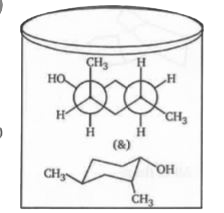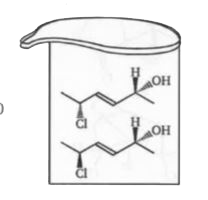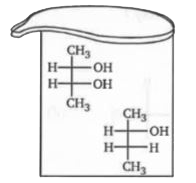A solution of d-glucose in water rotates the plane polarised light
towards right
towards left
towards either side
none of the above
The correct Answer is:A
To solve the question regarding the optical activity of a D-glucose solution in water, we can follow these steps:
1. Understanding Optical Activity:
- Optical activity refers to the ability of a substance to rotate the plane of polarized light. This property is exhibited by certain compounds, including sugars like glucose.
2. Identifying D-Glucose:
- D-glucose is a specific form of glucose that is known to be optically active. It is one of the most common monosaccharides found in nature.
3. Direction of Rotation:
- When polarized light passes through an optically active substance, it can rotate the light either to the right (clockwise) or to the left (counterclockwise).
- Substances that rotate light to the right are termed "dextrorotatory" (denoted as +), while those that rotate it to the left are termed "levorotatory" (denoted as -).
4. D-Glucose's Optical Activity:
- D-glucose is classified as a dextrorotatory compound. Therefore, when a solution of D-glucose in water is exposed to plane polarized light, it will rotate the light towards the right.
5. Conclusion:
- Based on the properties of D-glucose, we conclude that the solution will rotate the plane polarized light towards the right.
Final Answer:
The solution of D-glucose in water rotates the plane polarized light towards the right.
---
- Optical activity refers to the ability of a substance to rotate the plane of polarized light. This property is exhibited by certain compounds, including sugars like glucose.
- D-glucose is a specific form of glucose that is known to be optically active. It is one of the most common monosaccharides found in nature.
- When polarized light passes through an optically active substance, it can rotate the light either to the right (clockwise) or to the left (counterclockwise).
- Substances that rotate light to the right are termed "dextrorotatory" (denoted as +), while those that rotate it to the left are termed "levorotatory" (denoted as -).
- D-glucose is classified as a dextrorotatory compound. Therefore, when a solution of D-glucose in water is exposed to plane polarized light, it will rotate the light towards the right.
- Based on the properties of D-glucose, we conclude that the solution will rotate the plane polarized light towards the right.
The solution of D-glucose in water rotates the plane polarized light towards the right.
Topper's Solved these Questions
- ANIMAL TISSUES BOOK - TRUEMEN BIOLOGY ENGLISHCHAPTER - ANIMAL TISSUES EXERCISE - MULTIPLE CHOICE QUESTIONS
193 Videos
- CELL- THE BASIC UNIT OF LIFE ( CELL AND ITS STRUCTURAL ORGANISATION )BOOK - TRUEMEN BIOLOGY ENGLISHCHAPTER - CELL- THE BASIC UNIT OF LIFE ( CELL AND ITS STRUCTURAL ORGANISATION )EXERCISE - MULTIPLE CHOICE ANSWER TYPE
308 Videos
Similar Questions
Knowledge Check
Which of the following molecules is expected to rotate the plane polarized light?
A B
B C
C D
D
Which mixture of structure in each beaker would rotate plane polarized light ?
A B
B C
C DAll of these
DAll of theseWhich of following compound will rotate the plane polarized light at room temperature?
A B
B C
C D
D
Which of the following molecules is expected to rotate the plane polrized light?
View SolutionIn which direction does a d-isomer rotate the plane of plane polarised light?
View SolutionA : Nicol prism is used to produce and analyse plane polarised light.
R : Nicol prism reduces the intensity of light to zero.
View SolutionWhat will be the molality of a solution of glucose in water which is 10%w/W ?
View SolutionName the prism passing through which ordinary light changes into plane polarised light.
View Solution
